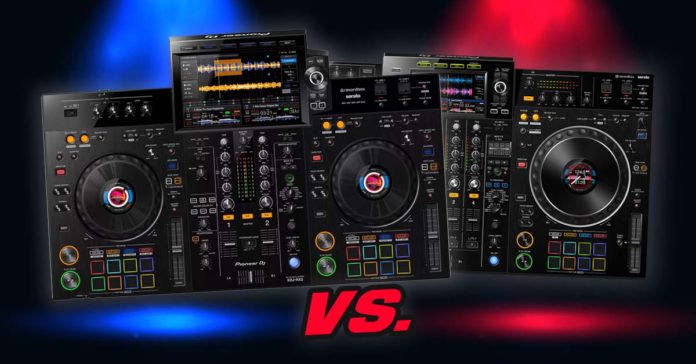Pioneer XDJ-XZ vs. Pioneer XDJ-RX3 DJ controller comparison. Which one should you get – XDJ-XZ or XDJ-RX3? These two Pioneer DJ controllers with standalone capabilities are currently among the best devices in this category. What are the main differences between the XDJ-RX3 and the XDJ-XZ? Here we present our extensive comparison of these two high end devices.
- Touch display differences
- Mixer sections (and usable mixer channels)
- Available audio FX
- Performance pads
- XDJ-RX3 and its Release FX pad mode
- Standalone features
- Jog wheels
- Software compatibility
- Inputs and outputs
- Price and availability
- Pros and cons
- The conclusion – which one should you get?
This web portal is reader-supported, and is a part of the Amazon Services LLC Associates Program and the eBay Partner Network. When you buy using links on our site, we may earn an affiliate commission!
Top 10 Best DJ Controllers With Built-In Screens (Full List!)
Touch display differences
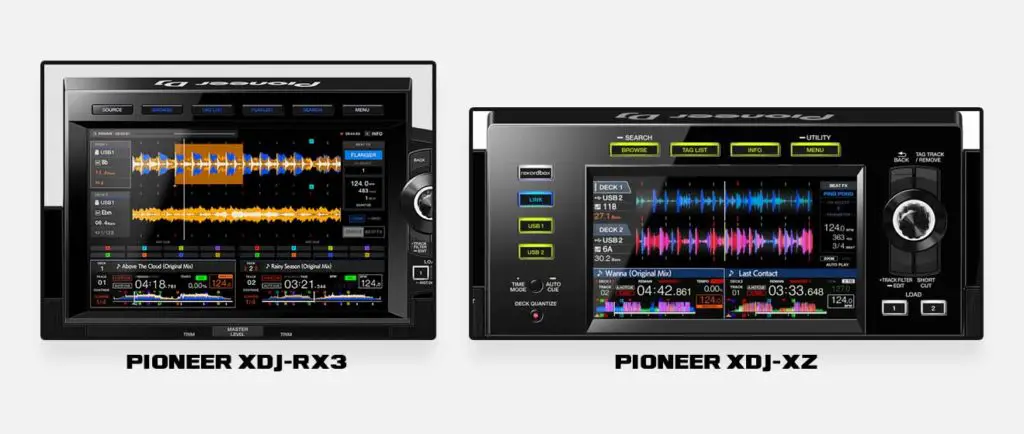
The screen on the Pioneer XDJ-RX3 is a 10.1 inch touch display with a 1280×800px resolution. The GUI on the RX3 is extremely close in terms of visuals and functionality to the one present on the Pioneer CDJ-3000 players – in fact they are almost identical.
Pioneer XDJ-XZ features a simple 7 inch touch screen based on the displays present on older Pioneer CDJ-2000 players. It’s inferior to the new updated screen on the XDJ-RX3 in many places, as it’s based on much older technology.
Pioneer XDJ-RX3 vs. XDJ-RX2 (Direct comparison)
On Pioneer XDJ-RX3 with the aid of the updated touch screen you can for instance preview your tracks by pressing and holding them in the library view, or use the needle search feature during your mix. You cannot do these things on the older XDJ-XZ.
Also, Pioneer XDJ-RX3 has 2 more touch screen related features to offer: an on-screen X-pad (present on the XDJ-XZ on the FX section) and on-screen FX bank buttons that let you store custom Beat FX configurations (no such thing on the XDJ-XZ).
Pioneer XDJ-XZ vs. Denon DJ Prime 4 (Ultimate Comparison)
Touch displays on both the XDJ-XZ and the XDJ-RX3 sadly do not support multi touch, nor on-screen gestures – they are still simple resistive displays. Denon DJ Prime 4 is ahead on Pioneer on this one!
Mixer sections (and usable mixer channels)
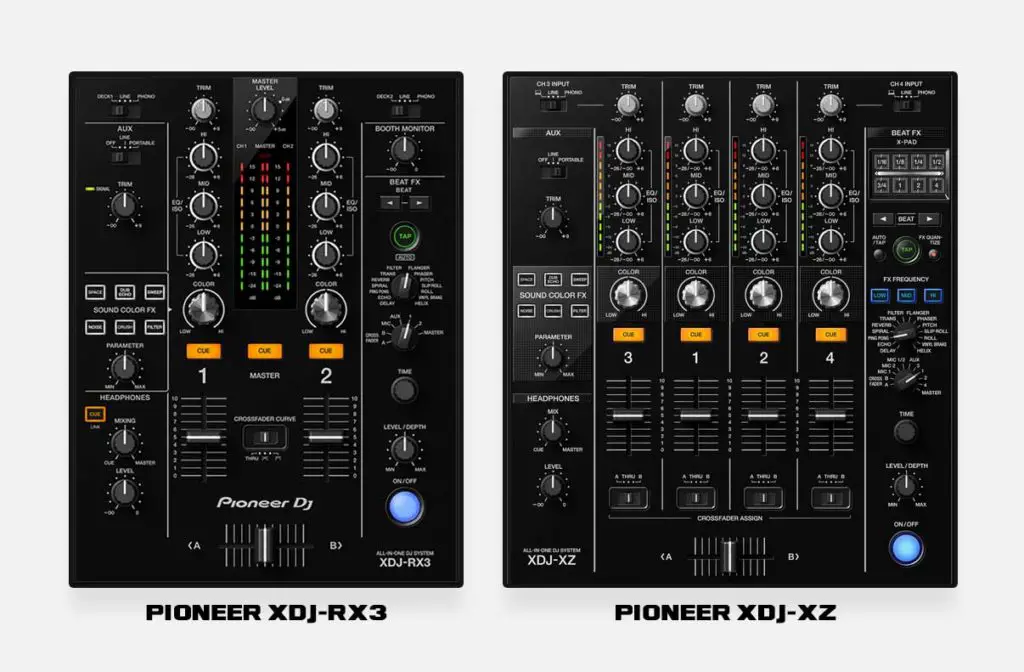
First noticeable difference between the two is that the Pioneer XDJ-XZ features 4 mixer channels, while the XDJ-RX3 only has 2 channels on board.
It’s important to remember though, that on the Pioneer XDJ-XZ you cannot fully utilize all 4 virtual decks while in standalone mode. On the XDJ-XZ only two virtual decks are available to you when you’re not connected to your computer.
You can make use of the decks 3 and 4 either once you use your Pioneer XDJ-XZ with additional audio devices plugged in (such as CD players or turntables), you’re using the Pioneer Pro DJ Link functionality (connecting your Pioneer CDJ players to the XZ using LAN internet cables).
Virtual decks 3 and 4 are available only when you’re using your XDJ-XZ as a DJ controller plugged into your computer with a USB cable.
Pioneer XDJ-RX3 has only 2 mixer channels to begin with, and so it supports only 2 virtual decks.
Available audio FX
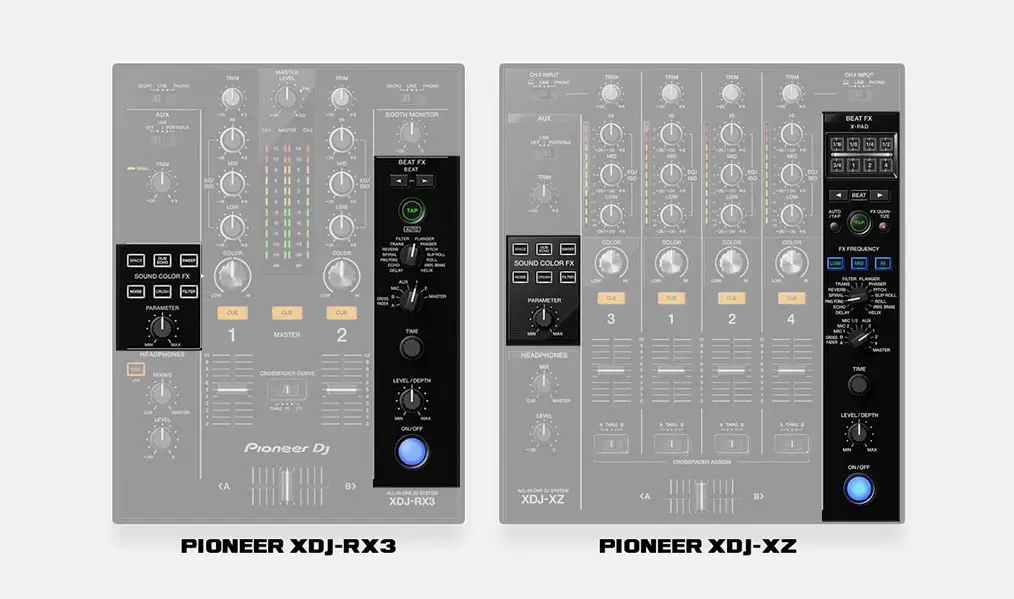
The FX sections on the XDJ-RX3 and the XDJ-XZ are almost exactly the same. They both feature 14 Beat FX and 6 Sound Color FX.
Additionally, Pioneer XDJ-XZ has a nice additional feature – FX frequency isolation control. Three buttons placed in the FX section – lo, mid and hi, enable you to control which frequency ranges on an audio channel will be affected by a chosen effect. There are no FX frequency isolation controls on the Pioneer XDJ-RX3.
Pioneer XDJ-RX3 vs. XDJ-RX2 (Direct comparison)
Pioneer XDJ-RX3 on the other hand has the previously mentioned on-screen X-pad, on-screen FX bank and Release FX pad mode. You can read more about those in our XDJ-RX2 vs. XDJ-RX3 comparison here.
Pioneer XDJ-XZ has a dedicated physical X-pad on the Beat FX strip on the right side of the mixer section.
Performance pads
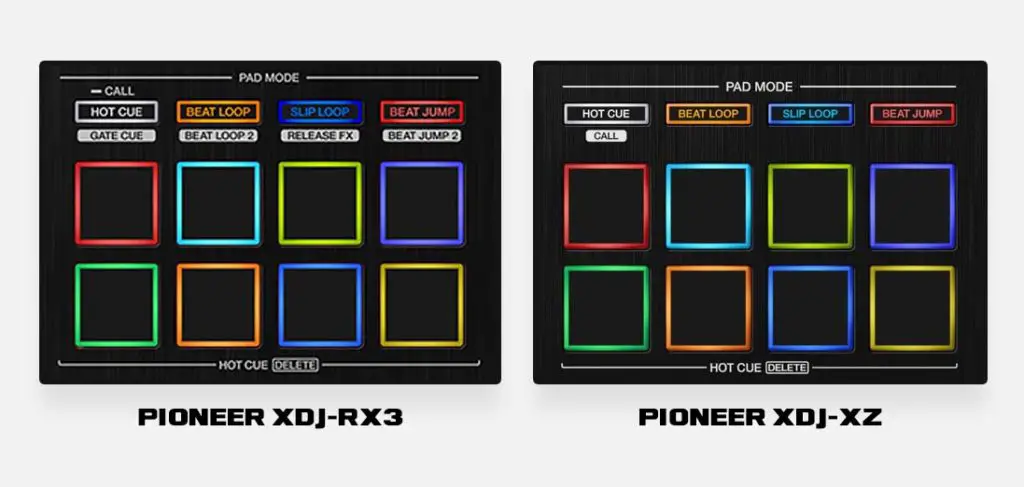
The performance pads on the XDJ-RX3 and the XDJ-XZ don’t really differ in terms of build quality. Instead, they differ when it comes to their functionalities.
Pioneer XDJ-RX3 in the standalone mode, compared to the XDJ-XZ lets you use some additional pad modes that may be of interest to you. Here we will list all the pad modes available on both units.
As we can see, XDJ-RX3 has much more to offer in terms of performance pad related features. It also has an additional Release FX pad mode that gives you access to 8 bonus FX to use outside of the unit’s main audio FX section.
Pioneer XDJ-XZ vs. Denon DJ Prime 4 (Ultimate Comparison)
Performance pad modes on the Pionner XDJ-RX3 (standalone mode):
- Hot-cue – A standard hot-cue mode.
- Beat Loop – Auto Loop (1/4 beat to 32 beat one-click loop presets).
- Slip Loop – The same as Roll – momentary loop presets (1/16 beat to 2 beat + 1/3 and 3/4 beat presets).
- Beat Jump – Allows you to jump through the track forwards and backwards by fixed beat intervals.
- Gate Cue – Hot cues that play only for as long as you’re holding down a pad.
- Beat Loop 2 – Features 8 additional irregular timing loops like for example triplets.
- Release FX – 8 additional audio FX (described futher in the next paragraph).
- Beat Jump 2 – Second Beat Jump mode with shorter beat divisions.
Performance pad modes on the Pioneer XDJ-XZ (standalone mode):
- Hot Cue – A standard hot-cue mode.
- Beat Loop – Same as on the XDJ-RX3 (see above).
- Slip Loop – Same as on the XDJ-RX3.
- Beat Jump – Same as on the XDJ-RX3.
Denon DJ SC Live 4 vs. Prime 4 (Direct Comparison!)
XDJ-RX3 and its Release FX pad mode
The Release FX pad mode gives you access to 8 bonus audio FX activated by pressing one of the performance pads.
Here is a brief description of all 8 Release FX that you can use on the Pioneer XDJ-RX3:
- Vinyl break – A classic turntable stop effect.
- Short backspin – Traditional short vinyl backspin.
- Echo out – 1 beat loop slowly decreasing in volume mimicking an echo out transition.
- Mute – Mutes the channel audio output while pressed down.
- Long vinyl break – A longer vinyl break effect.
- Long backspin – Longer backspin equal to several platter rotations.
- Buildup – Sets up a temporary loop progressively changing its length from 1 to 1/16 beat and then releases the effect automatically.
- Ducking – Fades the truck out by ducking the audio on each following beat.
Standalone features
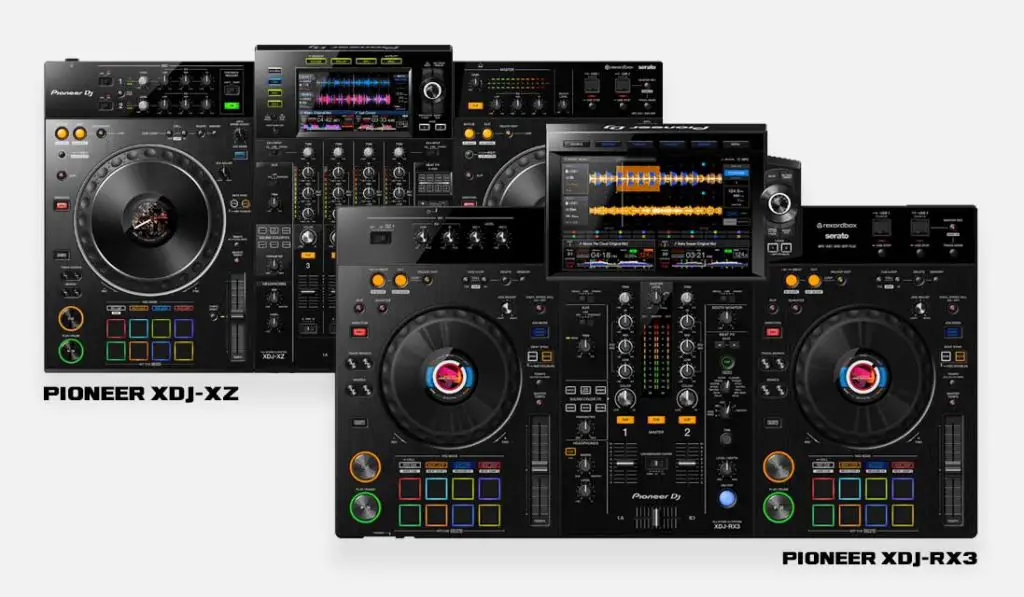
As we’ve mentioned before, on the XDJ-XZ you can use only 2 mixer channels with virtual decks in the standalone mode. Channels 3 and 4 would be available only if you were to connect additional audio devices such as players or turntables to your unit.
On the XDJ-RX3 the situation is similar, as the device only has 2 mixer channels to begin with, but keep in mind that while you can easily hook up external audio devices to your XDJ-XZ without sacrificing a physical mixer channel, on the XDJ-RX3 it’s simply not possible.
Aditionally, Pioneer XDJ-XZ while connected to your computer functions as a full fledged 4 channel DJ controller – on the XDJ-RX3 you are still stuck with just 2 channels even when it’s plugged into your laptop.
If we’d have to choose between these two units looking at standalone performance alone, we would most probably choose the Pioneer XDJ-RX3 because of additional performance pad modes, smaller size and easy live track management using the updated screen.
Sadly neither of these DJ controllers let you use key shift or key sync features while in standalone mode.
You also cannot analyze tracks on either the XDJ-XZ or the XDJ-RX3, all your tracks must be pre-analyzed using Rekordbox software in case of both devices.
Jog wheels

Pioneer XDJ-RX3 features capacitive jog wheels with built in displays. XDJ-XZ on the other hand, has much larger, mechanical jog wheels almost identical to those present on the CDJ-2000NXS players. These also features in-built LCD screens.
The difference between the mechanical and capacitive jog wheels is roughly speaking, that capacitive platters detect when you’re touching their top surface using their touch-sensitive surface, so they will react to every smallest touch, while mechanical jog wheels will only detect that you’re touching them when you press down on them a bit. Choosing one jog wheel type over the other purely a matter of personal preference.
Both units have jog wheel tension adjuts knobs located next to each platter.
Software compatibility
Aside from being great standalone devices, both these units can be used as standard MIDI controllers when they are connected to your computer.
XDJ-RX3 and XDJ-XZ work with Serato DJ Pro and Rekordbox out of the box, and both of them will unlock the full version of Serato DJ Pro when plugged into your computer.
Virtual DJ also claims to support the XDJ-XZ and the XDJ-RX3, and there are some unofficial mappings for Traktor DJ software as well (for now we’ve found such mappings only for XDJ-XZ).
Inputs and outputs
In terms of inputs and outputs, the Pioneer XDJ-RX3 features an additional 3.5mm or 1.8 inch jack portable audio input which the XDJ-XZ doesn’t have.
The XDJ-XZ on the other hand, has 3 LAN network sockets on board, that let you make use of the Pioneer Pro DJ Link functionality which lets you connect additional Pioneer Players to your XDJ-XZ and fully utilize all 4 mixer channels on the device.
Other than that, the Pioneer XDJ-XZ has a built-in feedback reducer that can help you minimize the mic feedback in difficult conditions.
Both XDJ-RX3 and the XDJ-XZ feature an in-built power supply. This means that you don’t have to worry about carrying an additional power brick when using one of these devices – the only thing you need is a standard power cable.
Inputs and outputs – Pioneer XDJ-RX3:
| Inputs | – 2x LINE (RCA) – 2x PHONO (RCA) – 2x AUX (RCA & 1/8 inch stereo mini-jack) – 2x MIC (XLR & 1/4 inch TRS Jack) |
|---|---|
| USB | – 2x USB A ports – 1x USB B port |
| Outputs | – 2x MASTER (XLR, RCA) – 1x BOOTH (1/4 inch TRS Jack) – 2x PHONES (1/4 inch stereo jack, 1/8 inch stereo mini-jack) |
Audio Jack Sizes – Inches To Millimeters – New Jack Cable Guide
Inputs and outputs – Pioneer XDJ-XZ:
| Inputs | – 2x LINE (RCA) – 2x PHONO (RCA) – 1x AUX (RCA) – 2x MIC (XLR & 1/4 inch TRS Jack) |
|---|---|
| LAN | – 3x (100Base TX) |
| USB | – 2x USB A ports – 1x USB B port |
| Outputs | – 2x MASTER (XLR, RCA) – 1x BOOTH (1/4 inch TRS Jack) – 2x PHONES (1/4 inch stereo jack, 1/8 inch stereo mini-jack) – 1x SEND (1/4 inch TRS Jack) |
Price and availability
You can get your Pioneer XDJ-RX3 and the Pioneer XDJ-XZ in the official Pioneer DJ Amazon store linked here:
| Controller | Features | Price |
|---|---|---|
| Pioneer XDJ-RX3: – Great standalone experience. – Quality 10 inch touch display. – Lots of audio FX to choose from. | Check the price on Amazon Check the price on Ebay | |
| Pioneer XDJ-XZ: – Full size quality mechanical jog wheels. – You can use all 4 channels when connected to your computer. – Pioneer Pro DJ Link support. | Check the price on Amazon Check the price on Ebay |
Pros and cons
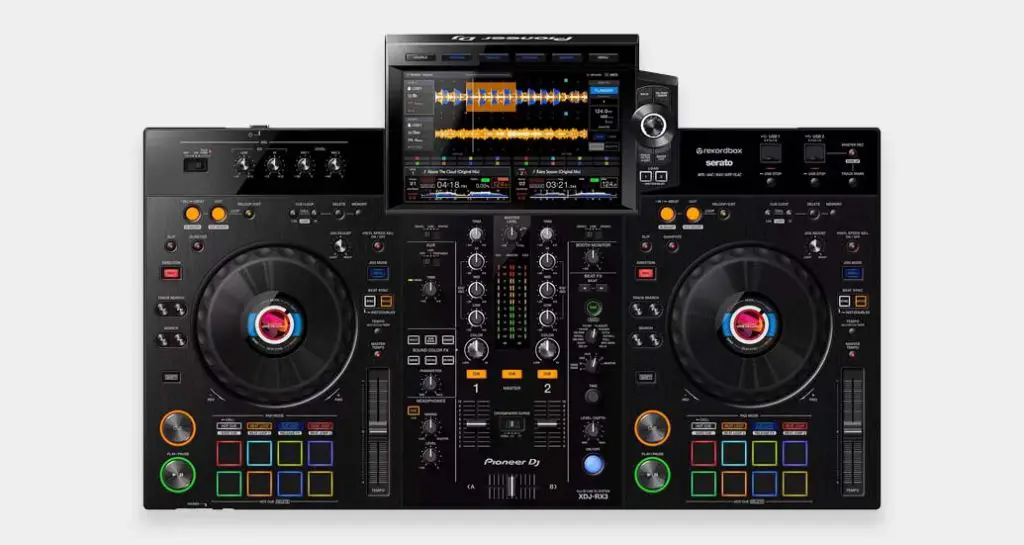
Pros:
- High quality upgraded LCD screen + CDJ-3000 like user interface.
- Great standalone mixing experience.
- Additional FX options – Pad Release FX and on-screen Beat FX preset bank.
- Jog wheel tension controls for each jog wheel.
- Additional portable audio input (1/8 inch jack).
Cons:
- The touch screen is great but it’s still just a resistive display – no gestures, scrolling or multi-touch functionality.
- No key shift or key sync in standalone mode + no on-board track analysis.
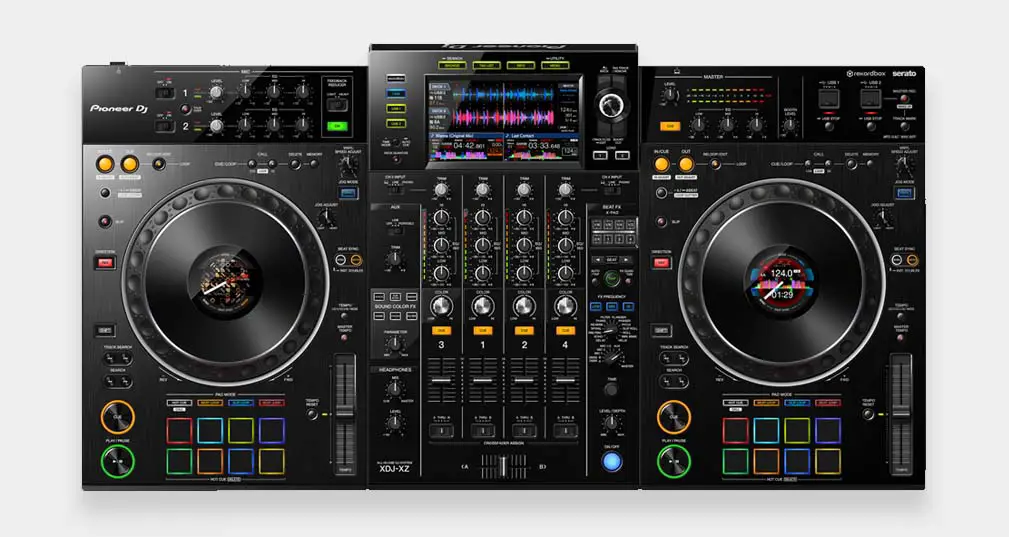
Pros:
- Audio FX frequency isolator.
- Feedback reducer feature for the microphone input.
- Jog wheel tension controls for each jog wheel.
- Pioneer Pro DJ Link support.
Cons:
- Supports just 2 mixer channels (2 virtual decks) in standalone mode.
- Resistive touch screen – no gestures, scrolling, or multi-touch support.
- No key shift or key sync in standalone mode + no on-board track analysis.
| Pioneer XDJ-RX3 on Ebay: |
| Pioneer XDJ-XZ on Ebay: |
The conclusion – which one should you get?
Both of these units are high-end professional DJ controllers with top-notch standalone features and you won’t be disappointed with any of them. However, the Pioneer XDJ-RX3 seems to be a few steps ahead of the XDJ-XZ in terms of the touch display and audio FX.
It’s also important to note the difference in weight and size between the two – XDJ-XZ weighs around 28.66lb / 13kg and is quite builky, when the XDJ-RX3 weighing around 20.5 lb / 9.3 kg is a bit smaller and thus better manageable when it comes to transport.
Our general recommendation would be to go straight for the newer, upgraded Pioneer XDJ-RX3, unless you plan to utilize your Pioneer DJ players, or any kind of external audio devices alongside with your standalone unit – then your best choice would be the Pioneer XDJ-XZ.
If you want to know more, be sure to check our detailed comparison between the XDJ-RX2 and the XDJ-RX3!
Check out also the Denon DJ Prime 4 – it’s really similar to the Pioneer XDJ-XZ, but it doesn’t have many flaws that the XZ has. Also, it’s touch display is one of the best you can get when it comes to standalone DJ devices in this price range!
Pioneer XDJ-XZ vs. Denon DJ Prime 4 (Ultimate Comparison)

